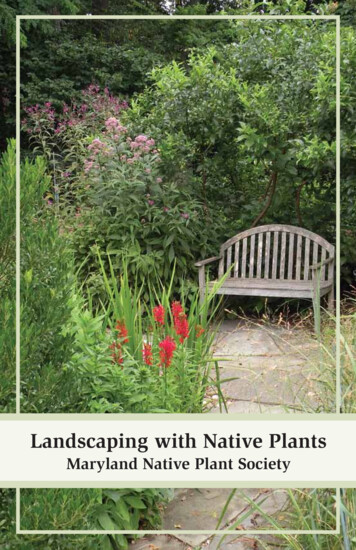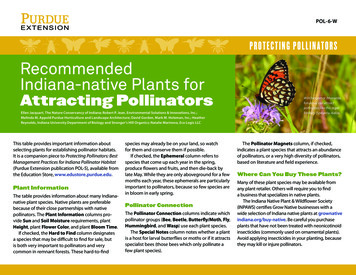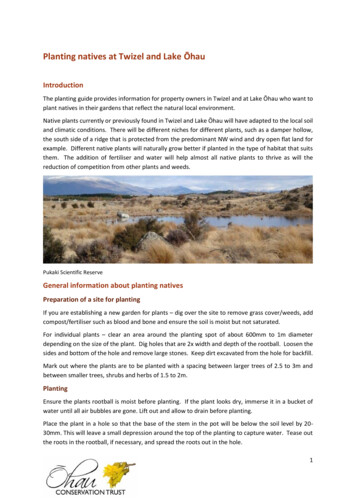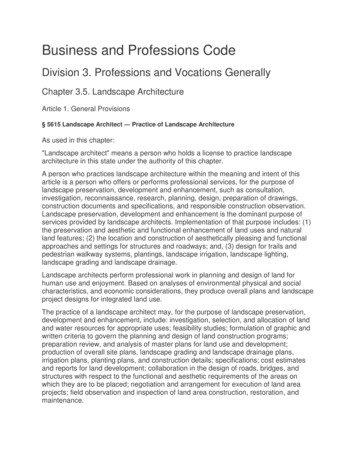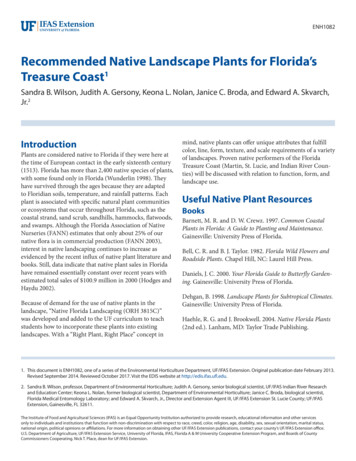
Transcription
ENH1082Recommended Native Landscape Plants for Florida’sTreasure Coast1Sandra B. Wilson, Judith A. Gersony, Keona L. Nolan, Janice C. Broda, and Edward A. Skvarch,Jr.2IntroductionPlants are considered native to Florida if they were here atthe time of European contact in the early sixteenth century(1513). Florida has more than 2,400 native species of plants,with some found only in Florida (Wunderlin 1998). Theyhave survived through the ages because they are adaptedto Floridian soils, temperature, and rainfall patterns. Eachplant is associated with specific natural plant communitiesor ecosystems that occur throughout Florida, such as thecoastal strand, sand scrub, sandhills, hammocks, flatwoods,and swamps. Although the Florida Association of NativeNurseries (FANN) estimates that only about 25% of ournative flora is in commercial production (FANN 2003),interest in native landscaping continues to increase asevidenced by the recent influx of native plant literature andbooks. Still, data indicate that native plant sales in Floridahave remained essentially constant over recent years withestimated total sales of 100.9 million in 2000 (Hodges andHaydu 2002).Because of demand for the use of native plants in thelandscape, “Native Florida Landscaping (ORH 3815C)”was developed and added to the UF curriculum to teachstudents how to incorporate these plants into existinglandscapes. With a “Right Plant, Right Place” concept inmind, native plants can offer unique attributes that fulfillcolor, line, form, texture, and scale requirements of a varietyof landscapes. Proven native performers of the FloridaTreasure Coast (Martin, St. Lucie, and Indian River Counties) will be discussed with relation to function, form, andlandscape use.Useful Native Plant ResourcesBooksBarnett, M. R. and D. W. Crewz. 1997. Common CoastalPlants in Florida: A Guide to Planting and Maintenance.Gainesville: University Press of Florida.Bell, C. R. and B. J. Taylor. 1982. Florida Wild Flowers andRoadside Plants. Chapel Hill, NC: Laurel Hill Press.Daniels, J. C. 2000. Your Florida Guide to Butterfly Gardening. Gainesville: University Press of Florida.Dehgan, B. 1998. Landscape Plants for Subtropical Climates.Gainesville: University Press of Florida.Haehle, R. G. and J. Brookwell. 2004. Native Florida Plants(2nd ed.). Lanham, MD: Taylor Trade Publishing.1. This document is ENH1082, one of a series of the Environmental Horticulture Department, UF/IFAS Extension. Original publication date February 2013.Revised September 2014. Reviewed October 2017. Visit the EDIS website at http://edis.ifas.ufl.edu.2. Sandra B. Wilson, professor, Department of Environmental Horticulture; Judith A. Gersony, senior biological scientist, UF/IFAS Indian River Researchand Education Center; Keona L. Nolan, former biological scientist, Department of Environmental Horticulture; Janice C. Broda, biological scientist,Florida Medical Entomology Laboratory; and Edward A. Skvarch, Jr., Director and Extension Agent III, UF/IFAS Extension St. Lucie County; UF/IFASExtension, Gainesville, FL 32611.The Institute of Food and Agricultural Sciences (IFAS) is an Equal Opportunity Institution authorized to provide research, educational information and other servicesonly to individuals and institutions that function with non-discrimination with respect to race, creed, color, religion, age, disability, sex, sexual orientation, marital status,national origin, political opinions or affiliations. For more information on obtaining other UF/IFAS Extension publications, contact your county’s UF/IFAS Extension office.U.S. Department of Agriculture, UF/IFAS Extension Service, University of Florida, IFAS, Florida A & M University Cooperative Extension Program, and Boards of CountyCommissioners Cooperating. Nick T. Place, dean for UF/IFAS Extension.
Huegel, C. N. 2010. Native Plant Landscaping for FloridaWildlife. Gainesville: University Press of Florida.Nelson, G. 1996. The Shrubs & Woody Vines of Florida.Sarasota, FL: Pineapple Press.———. 2000. The Ferns of Florida. Sarasota, FL: PineapplePress.———. 2010. Best Native Plants for Southern Gardens.Gainesville: University Press of Florida.———. 2010. The Trees of Florida (2nd ed.). Sarasota, FL:Pineapple Press.———. 2011. Botanical Keys to Florida’s Trees, Shrubs andWoody Vines. Sarasota, FL: Pineapple Press.Rogers, G. K. 2011. Landscape Plants for South Florida.Palm Beach Gardens, FL: George Rogers Publishing.Simberloff, D., D. C. Schmitz, and T. C. Brown (eds.). 1997.Strangers in Paradise. Washington, D. C.: Island Press.Suncoast Native Plant Society. 1997. The Right Plants forDry Places. St. Petersburg, FL: Great Outdoors Publishing.Taylor, W. K. 2009. A Guide to Florida Grasses. Gainesville:University Press of Florida.Wasowski, S. and A. Wasowski. 2010. Gardening withNative Plants of the South. Lanhsam, MD: Taylor TradePublishing.Wunderlin, R. P. and B. F. Hansen. 2011. Guide to theVascular Plants of Florida (3rd ed.). Gainesville: UniversityPress of Florida.Useful Native Plant WebsitesCowley, M. 1997–2005. Florida’s Native Plants. Usefulinformation about native gardening, plants for birds, andbutterfly plants. http://www.nsis.org/garden.Florida Association of Native Nurseries. 2013. Containswholesale and retail plant listings, news and events, anduseful “know the difference” articles. http://www.floridanativenurseries.org/.Florida Wildflowers Growers Cooperative. 2013. Informative brochures, planting information, seed availability, andphoto gallery. http://www.floridawildflowers.com/.Recommended Native Landscape Plants for Florida’s Treasure CoastFlorida-Friendly Landscaping (FFL) Program. 2011.Informative website with designing information, plantdatabase, landscaping tips, and glossary. Teaches homeowners about low-maintenance plants and environmentallysustainable practices. http://fyn.ifas.ufl.edu. (Direct link tothe Florida-friendly interactive database and yard at http://www.floridayards.org/.)Native Plants Network. 2009. A forum for dispersingpractical information about planting and growing nativeplants for conservation, restoration, reforestation, andlandscaping. Bloomington: Indiana University Press. http://www.nativeplantnetwork.org.Reforestation, Nurseries, & Genetic Resources (RNGR).This program’s mission and site is to supply people whogrow forest and conservation seedlings with the verylatest technical information and to provide links to otherorganizations and individuals with similar interests. http://www.rngr.net.The Florida Native Plant Society. 2011. Information aboutupcoming native conferences, local chapters, and publication links. The site also contains a state map where you canclick on your county and see what native species grow inyour area. http://www.fnps.org/Wilson, S. B. 2011. Florida Native Landscaping. Websitecontains a virtual garden tour and hyperlinked plantidentification sheets showing flower, fruit, form, and leafcharacteristics. ated EDIS or County ExtensionPublicationsAllen, G. M., M. D. Bond, and M. B. Main. 2012. 50 Common Native Plants Important In Florida’s EthnobotanicalHistory. Cir 1439. Gainesville: University of Florida Instituteof Food and Agricultural Sciences. http://edis.ifas.ufl.edu/uw152.Haynes, J., J. McLaughlin, and L. Vasquez. n. d. NativeLandscape Plants for South Florida. nt-list.PDF.Meerow, A. W., T. K. Broschat, and H. M. Donselman. 2011.Native Trees for South Florida. EES-57. Gainesville: University of Florida Institute of Food and Agricultural Sciences.http://edis.ifas.ufl.edu/eh157.2
Norcini, J. G. 2012. Native Plants: An Overview. ENH1045.Gainesville: University of Florida Institute of Food andAgricultural Sciences. http://edis.ifas.ufl.edu/ep297.Sources to Obtain Native Plants forthe Treasure CoastFort Pierce, FL 34945, 772-468-3922, http://www.irrec.ifas.ufl.eduMounts Botanical Gardens, 531 North Military Trail, WPalm Beach FL 33415, 561-233-1757, http://www.mounts.orgFlorida Association of Native Nurseries (FANN). NativePlant & Service Directory. Wholesale and retail catalogsavailable online at www.afnn.org.Pan’s Garden, 386 Hibiscus Ave., Palm Beach, FL 33480,561-832-0731, eaction pages.edupansgarden&x 9001398D. R. Bates Liners Plus, 17639 64th Place North, Loxahatchee, FL 33470, 561-790-3246, E-mail: professionals/detail/179Local Treasure Coast Chapters ofthe Florida Native Plant SocietyIndian Trails Native Nursery, 6315 Park Lane West, LakeWorth, FL 33467-6606, http://indiantrails.vpweb.com/Maple Street Natives, 2395 Maple Street, W. Melbourne FL32904, 321-729-6857, http://www.maplestreetnatives.comMeadow Beauty Nursery, 5782 Ranches Road, Lake Worth,FL 33463, 561-601-9673, http://meadowbeautynursery.com/Mesozoic Landscapes, 7667 Park Lane Road, Lake WorthFL 33467-6728, 561-967-2630, E-mail: moyround@prodigy .netThe Natives, 2929 JB Carter Road, Davenport, FL 33837,863-422-6664, http://www.thenatives.netPlant Real Florida. A website dedicated to homeowners thatlists landscape professionals, environmental consultants,garden and landscape products for native landscaping, andretail nurseries and garden centers that sell native plants.Also contains relevant information on native plants andlandscaping with natives. http://www.plantrealflorida.org/Gardens within or Near theTreasure Coast with Native PlantDisplaysEnvironmental Learning Center, 255 Live Oak Drive, VeroBeach, FL 32963, 772-589-5050, http://www.elcweb.org.Heathcote Botanical Gardens, Inc., 210 Savannah Road,Fort Pierce, FL 34982, 772-464-4672, http://www.heathcotebotanicalgardens.orgConradina Chapter, Melbourne. Region: Southern portionof Brevard County.Eugenia Chapter, Vero Beach. Region: Indian River County.Lakela’s Mint Chapter, Fort Pierce. Region: St. LucieCounty.Cocoplum Chapter, Jensen Beach. Region: Martin County.***For statewide membership information and meetingdates and locations of local chapters, see http://www.fnps.org.Literature CitedFlorida Association of Native Nurseries (FANN). 2003.Native Plant & Service Directory. Retrieved 10 April 2007.htpp://www.afnn.org.Hodges, A. W. and J. J. Haydu. 2002. Economic Impacts ofthe Florida Environmental Horticultural Industry, 2000.Econ. Info. Rpt. EI 02-3, Food and Resource EconomicsDepartment. Gainesville: University of Florida Institute ofFood and Agricultural Sciences.Wunderlin, R. P. 1998. Guide to Vascular Plants. Gainesville:University Press of Florida.Table 1. Florida Native Landscape Plants for the TreasureCoast: Foundation.Table 2. Florida Native Landscape Plants for the TreasureCoast: Accent.Table 3. Florida Native Landscape Plants for the TreasureCoast: Privacy.IRREC Teaching Garden, Indian River Research andEducation Center, University of Florida, 2199 S. Rock Road,Recommended Native Landscape Plants for Florida’s Treasure Coast3
Table 4. Florida Native Landscape Plants for the TreasureCoast: Color.Table 5. Florida Native Landscape Plants for the TreasureCoast: Vines and Groundcovers.Table 6. Florida Native Landscape Plants for the TreasureCoast: Specimen Trees.Table 7. Florida Native Landscape Plants for the TreasureCoast: Trees for Small Places.Recommended Native Landscape Plants for Florida’s Treasure Coast4
Table 1. Florida Native Landscape Plants for the Treasure Coast: ameGrowth rateHeight/widthDescription/commentsSea ox-eyedaisyModerate tofast2-4 ft tall2-3 ft widePubescent gray-green foliage; large yellowdaisy-like flowers attract butterflies; salttolerant plants spread by rhizomes and can behedged.Shiny, green dense foliage can be hedged;salt- and drought-tolerant; provides wildlifecover; varying colors of purple to white fruitare edible.ChrysobalanusicacoCocoplumModerate5-15 ft tall3 to 10 ft wideEugenia foetidaSpanishstopperSlow tomedium15-20 ft tall8-15 ft wideLarge shrub or small tree; can be pruned andmay have a rounded appearance; small ovalleaves and small red fruits are desirable towildlife.HymenocallislatifoliaSpider lilyModerateafter wellestablished2-3 ft tall2-3 ft wideDark green, clumping, maintenance-freeperennial with strap-like leaves producinglarge showy white flowers; salt-tolerant plantself maintains its height; also used as a groundcover and for borders.Ilex vomitoria‘Schilling’sor ‘SchillingsDwarf’Schilling’sdwarf hollySlow3-4 ft tall3-4 ft wideVery compact, dense with small leaves;drought-tolerant; dwarf forms are male and donot produce fruit.Moderate3-5 ft tall;1-3 ft wideCoarse, spoon-shaped leaves; dainty, whiteto light pink lace-like flower clusters areattractive to butterflies; dark pink to blue fruitare edible by wildlife.5-20 ft tall3-5 ft wideDensely branched leaves are variable inshape and color; some plants have reddishnew growth; dainty, fragrant white flowersfollowed by wildlife-edible orange-red berries;distinctive reddish flaking bark on matureplants; salt-tolerant plants can be hedged d lantana,wild sageSimpson’sstopperSlowRecommended Native Landscape Plants for Florida’s Treasure Coast5
ScientificnameMyrica naSennamexicana var.chapmaniiYuccafilamentosaZamia pumilaCommonnameSouthern waxmyrtleWild coffeeWhite indigoberryMyrsineChapman’ssennaAdam’s needleCoontieHeight/widthDescription/comments4-15 ft tall3-5 ft wideShort lived, salt tolerant; densely branched,multi-trunked and sometimes sucking shrubor small tree; soft, serrated, narrow leaves;female plants produce waxy berries onstems that are eaten by birds; prefers moistconditions but adaptable to dryer conditions;tolerates some pruning.5-15 ft tall3-5 ft wideMulti-stemmed bush with shiny, dark green,puckering leaves; clusters of tiny white flowersthat attract bees and butterflies are followedby red to maroon fruit eaten by birds; can behedged to desired height.3-6 ft tall3-4 ft wideDensely foliated, rounded to oval, leatheryleaves; stiff branches, small white flowers andwhite berries with blue pulp; some ecotypesbear spines; indestructible and droughttolerant once established.5-10 ft tall3-4 ft wideVersatile to dry or moist conditions and sunor shade; salt tolerant; dark green shiny leaveshave lighter mid-vein; small, greenish whiteinconspicuous flowers; female plants producesmall dark brown or black fruits that attractbirds; plants can be pruned.Fast3-6 ft tall2-4 ft wideShort lived, drought- and salt-tolerant woodyperennial; loosely branching evergreen is hostfor sulphur butterfly caterpillars; prominentclusters of large yellow flowers borne onthe leaf axils give rise to flat brown capsulescontaining seeds that are easily propagated.Slow2-3ft tall2-3ft wideFlower paniclecan reach upto 12 feet butusually under7 feetSlow2-3 feet tall2-4 feet wideGrowth rateModerateModerate tofastSlowSlowRecommended Native Landscape Plants for Florida’s Treasure CoastThe leafy basal rosette of leathery grass-likeleaves of this stout perennial make a greatfoundation plant; annual, showy panicles ofwhite flowers that can soar to 12 feet shouldbe considered; adds a southwestern desertlike look to the garden; salt- and droughttolerant.Dark green, stiff, fern-like leaves; this cycadresembles a trunk-less palm; salt- and droughttolerant; when used as a foundation plantingwill not need hedging.6
Table 2. Florida Native Landscape Plants for the Treasure Coast: Accent.Scientific NameGrowth erate4-6 ft tall3-5 ft wideDeciduous or semi-deciduous shrub with pinkto lavender flowers followed by persistentpurple fruit.Slow4 -6 ft tall4 - 6 ft wideSingle-stemmed evergreen fan palm havingspiny stems; inconspicuous flowers arefollowed by reddish brown fruit; prefers moistconditions.Recumbent, spiny, clumping palm producingwhite flower clusters followed by dark purplefruit; silver and green forms available; droughtand salt tolerant.Needle palmSerenoa repensSaw palmettoSlowHeight andwidth varywith form, butusually lessthan 8 ftTripsacumdactyloidesFakahatcheegrassFast4-8 ft tall3-4 ft wideClumping perennial grass producingbrownish flower spikes above the foliage.YuccafilamentosaAdam’s needleSlow3 ft tall3 ft wideBasal, somewhat twisted foliage witherect, large, cream-colored flower paniclesprotruding several ft. above foliage.Recommended Native Landscape Plants for Florida’s Treasure Coast7
Table 3. Florida Native Landscape Plants for the Treasure Coast: Privacy.Scientific NameCommonNameGrowth feraConocarpuserectusDodonaeaviscosaEugenia foetidaForestierasegregataSea grapeGreenbuttonwoodVarnish mments20 ft tall insun, 10 ft inshadeLarge evergreen shrub suitable for a hedge inshady locations; can be trimmed to desiredheight; dark green, glossy, large leaves with lightmid vein; clusters of small, white fragrant flowersfollowed by fruit turning purple to black whenripened.Salt- and drought-tolerant shrub with dense5-15 ft tallfoliage that makes an excellent plant for3 to 10 ft widescreening.3-35 feetVery large round leaves with prominent andattractive venation; can be sheared to form ahedge or trained and trimmed to tree form;leaves have some fall-like foliage color; largegrape-like fruit attract wildlife; salt and droughttolerant.Upright tree that branches outward with age andcan be trimmed to form a thick dense hedge;40-50 feet talldark green, shiny leaves with contrasting lighter5-10 feet widevenation; strong dense wood; salt and droughttolerant; also tolerant of wet conditions.8-12 ft tall6 ft wideMulti-trunked and naturally open habit with adenser look when trimmed for a screen or hedge;attractive, glossy leaves are coated with a naturalresin which protects the plant from salt spray anddrought; Winged fruit are very showy and changecolor from light green to creamy yellow to pink asthey mature; seeds are eaten by songbirds.SpanishstopperSlowSmall, evergreen tree or tall shrub with oval15-20 feet tall leaves, small white inconspicuous flowers and3-4 feet wide small berries turning from reddish orange toblack.Wild olive,Florida privetFast4-15 feet tall3-5 feet wideLarge shrub or small tree, dense foliage thatcan be hedged; female plants produce copiousamounts of blue-black fruit relished by songbirds.Recommended Native Landscape Plants for Florida’s Treasure Coast8
Growth RateHeight/widthFirebushFast3-10 feet tall3 to 6 feetwideMulti-stemmed shrub with highly variableleaf color from solid green to shades or red;tubular, red showy flowers attract butterfliesand hummingbirds and small fruit are eaten bysongbirds.IlliciumparviflorumYellow aniseSlow tomoderate6-15 feet tall3-4 feet wideEvergreen shrub with dark green licorice-scented,aromatic leathery leaves; prefers moist acidicsoils; small, pale yellow flower followed by aninteresting star-shaped fruit.JuniperusvirginianaSouthernjuniper,southern redcedarModerateThis large, coniferous tree makes an excellent20-60 feet tall tall thick hedge along a property border; small,10-30 feetscale-like leaves; male and female cones bornewideon separate trees, female cones are attractivelybluish and berrylike and eaten by birds.Scientific NameHamelia a rJamaicancaperWhite indigoberryMyrsineSlow tomoderate5-12 feet tall3-5 feet wideDescription/CommentsEvergreen, densely branched, variable in habitand leaf shape; small delicate, fragrant whiteflowers followed by orange to red fruit which areenjoyed by birds. Note: compact/dwarf cultivarsare available; choose the proper selection foryour intended use.SlowSmall densely branched evergreen tree withglossy, dark green leaves that can be clipped intoUp to 18 ft tall a hedge; fragrant, white spider-like flowers thatopen in the evening and wither by noon the nextday.Slow3-10 feet tall3-5 feet wideOval to round leathery dark green leaves, smallwhite, tubular, fragrant flowers; when ripe, fruit iswhite with dark purple to black pulp; salt tolerantwith stems having varying presence of spines.8-20 feet tall3-5 feet wideLarge shiny, thick leaves clustering at the endsof branches; female plants bear small dark blueto black fruit along the leafless portions of thestems; fruit attracts songbirds; highly versatile,tolerates dry or moist soil and sun or shade and issalt tolerant.Slow tomoderateRecommended Native Landscape Plants for Florida’s Treasure Coast9
Scientific NameVarronia flysageWalter’sviburnumGrowth RateFastSlowHeight/widthDescription/Comments4-9 ft tall4-6 ft wideDense branching to the ground makes this anideal plant for privacy; can be trimmed intoalmost any shape or height; leaves have roughtexture; small white flowers produce abundantnectar attracting numerous bees and butterflies;small red berries attract birds.6 to 30 feettall6 to 12 feetwideDensely branched and vegetated shrub thatcan tolerate shearing. Forms a dense thicket ofunderground suckers; flowering is profuse inspring with tiny white flowers borne in clusters;small berries red to black in autumn; providescover and food for birds and wildlife.Note: compact/dwarf cultivars are available;choose the proper selection for your intendeduse.Recommended Native Landscape Plants for Florida’s Treasure Coast10
Table 4. Florida Native Landscape Plants for the Treasure Coast: Color.ScientificNameCommonNameGrowth RateHeight/widthHerbaceous, stoloniferous perennial; leaveshave silvery grey pubescence; solitary flowershave attractive ray and disk petals; salt ensSea ox-eyedaisyFast2-3 ft eopsisFast1-2 ft tall,reseedingHerbaceous annual or short-lived perennial withglabrous basal leaves, yellow ray flowers and adark center disk.DodonaeaviscosaFlaveria elia patensVarnish leafFast8-12 ft tall6 ft wideEvergreen shrub having elliptic to spatulate,resinous leaves; inconspicuous flowers arefollowed by clusters of winged fruit that changecolor from light green to creamy yellow to pinkas they mature.YellowtopFast2-3 ft andspreadingHerbaceous perennial having linear leaves,reddish stems and showy yellow corymbs.BlanketflowerFast1-2 ft tall,reseedingHerbaceous, short-lived perennial with brilliantflower rays in shades of orange, red and yellow;drought and salt tolerant.TampaverbenaFast1-2 ft tall3-4 ft wideSprawling, short-lived perennial having pink/purple flowers borne in terminal corymbs.Fast6-12 ft tall(compactformsavailable)Small tree or large shrub having glabrous greenleaves turning to shades of red; tubular showyred to orange flowers are followed by red fruitturning purple in time.FirebushRecommended Native Landscape Plants for Florida’s Treasure Coast11
ScientificNameCommonNameGrowth wer3-5 ft tallFast, selfsowingHerbaceous perennial with narrow long leavesand yellow daisy-like flowers; tolerant of wetconditions.LantanadepressaPinelandlantana3- 6 ft tall4 ft wideModerateEvergreen shrub with aromatic leaves andyellow flowers appearing in bracteate heads.MonardapunctataMonarda,horsemint3 ft tall3 ft wideFast, selfsowingHerbaceous perennial with pubescent, aromaticleaves and purple spotted flower petals offsetby showy purple bracts.Silkgrass1-2 ft tallFastClump-forming, herbaceous perennial withlinear, silvery pubescent leaves and yellow daisylike flowers borne on elongated stems.Black-eyedSusan2-3 ft tallFast, selfsowingHerbaceous perennial with hirsute leavesand having yellow/orange/red ray petalssurrounding a dark brown, raised central disk.RuelliacaroliniensisWild petunia1 ft tallModerate, selfsowingHerbaceous perennial with strigose leaves andstems and 5-petaled purple flowers.Salvia coccineaTropical sage2-4 ft tallFast, selfsowingHerbaceous perennial with bilabiate red flowersproduced on determinate ded Native Landscape Plants for Florida’s Treasure CoastDescription/Comments12
ScientificNameSennamexicana var.chapmaniiSolidagosempervirensCommonNameGrowth na6-8 ft tall5-6 ft wideFastMulti-trunked evergreen shrub having pinnatelycompound leaves and abundant yellow flowersin axillary clusters of 4 to 9 blooms.Goldenrod4-5 ft tall2-3 ft wideFastHerbaceous perennial with smooth strap-likeleaves and attractive golden yellow flowersoccurring well above the foliage on spike-likeracemes.Sophoratomentosa var.truncataNecklace pod4-10 ft tall2-3 ft wideStachytarphetajamaicensisPorterweed3-4 ft tall3 ft wideStokesia laevisStokes’ aster,stokesia1-2 ft tall1 ft wideModerateEvergreen shrub having pinnately compound,smooth green leaves at maturity; yellowinflorescences occur above foliage in longspikes; fruit is pronouncedly constrictedbetween seeds; salt, drought and wind tolerant.Not to be confused with the non-nativeNecklace pod, Sophora tomentosa var. occientaliswhich has fuzzy, silvery or tomentose matureleaves and commonly sold in the landscapetrade.Evergreen, sprawling shrub becoming woodyFast, reseeding with age; having serrated leaf margins andpurple flowers borne on long spikes.ModerateRecommended Native Landscape Plants for Florida’s Treasure CoastHerbaceous perennial having basal, glabrousleaves and large solitary, purple flowers withfringed petals.13
Table 5. Florida Native Landscape Plants for the Treasure Coast: Vines and Groundcovers.Growth RateHeight/widthDescription/CommentsCanavalia roseaBeach bean,bay beanFastLow climbingvine and/orground coverLarge trifoliate leaves with pink, pea-likeflowers; produce large seed pods, can be usedas ground cover and will climb structures;wind, drought, heat and salt tolerant.DyschoristeoblongifoliaTwin flowerSlowGround cover6 to 12 inchestallDelicate small plants with pale lavenderflowers spreading by underground rhizomes;semi-dormant in winter.Eragrostis elliottiiElliott’s lovegrassFastGround cover1-2 feet tall1-2 feet wideA bunch grass with fine bluish or silvery greenleaves and delicate masses of flower spikesthat can be produced at any time of year butwith the most abundance in the autumn.GoldencreeperModerateGround cover1-2 feet tall,spreadingfrom 2 to 6feet wideGlossy green, fleshy leaves becoming tingedwith yellow as leaves age; small tubular whiteto pinkish flowers; salt, drought and heattolerant; good for erosion eModerateHigh climbing Twining vine with shiny leaves and brightand/or ground yellow flowers that attract hummingbirds andcoverbutterflies; blooms late winter/early spring.Helianthus debilisBeachsunflower,dunesunflowerScientific NameErnodea littoralisHymenocallislatifoliaCommonNameSpider lilyFastGround cover1-2 feet tallspreading upto 6 feet wideDrought- and salt-tolerant perennial withtriangular leaves and 2-inch yellow ray flowerswith brown disks that attract insects.FastGround cover2-3 ft tall2-3 ft wideClumping, herbaceous, low- maintenanceperennial forming dark green linear leavesfrom a central bulb base; large white flowerswith golden anthers are elevated above thefoliage.Recommended Native Landscape Plants for Florida’s Treasure Coast14
Scientific NameIpomoeapes-capraeLicania michauxiiLonicerasempervirensMelantheraniveaMimosa ataCommonNameRailroad vineGrowth RateHeight/widthFastGround cover6-8 inches tallSalt- and drought-tolerant, non-climbingperennial with large leaves and showy purpleflowers; good for stabilization of dry, sandyareas.Ground cover1-2 ft tallSalt- and drought-tolerant woody groundcover forming dense populations fromunderground stems; not tolerant of moisture;does best in full sun; 1-2 inch white to brownfruit is attractive to wildlife, hence the commonname “gopher apple”VineUp to 15 feetWoody twining vine; oval to oblong dark greenleaves with silvery undersurface; trumpetshaped, bright pink flowers with protrudingyellow stamens attractive to hummingbirdsand butterflies; produces small red berriesattractive to wildlife.Ground cover1-3 feet tall*1-4 feet wideTwo forms of Squarestem are found incultivation: An open, loosely coarse formthat grows to about 3 feet tall and a lowgrowing compact form that grows to about12-18 inches and spreads in a dense clump.Flowering most of the year, this later formmakes an excellent ground cover that is tough,and attractive to insects and people.Gopher appleSlowCoralhoneysuckleSlow toestablish butgrows quicklythereafterSquarestem;nonpareilModerate toFastDescription/CommentsSunshinemimosa;sensitive plantModerate toFastGround cover6-9 inches tallBeautiful pink flowers that are shaped likepuff balls and delicate leaflets that fold whentouched give this plant its common names;can be mowed and is drought tolerant onceestablished; stems creep and root when theytouch the ground.Muhly grassFastGround cover1-4 feet tall1-3 feet wideClumping grass with tightly rolled, threadlike leaves producing tall panicles of pink topurplish flowers in late summer or early fall.Ground cover2-4 feet tallLong, tapering fronds with numerous leafletsarranged pinnately possessing kidneyshaped clusters of spore cases; an excellentgroundcover for shady areas; not to beconfused with several species of non-nativeinvasive sword ferns.Boston fernFastRecommended Native Landscape Plants for Florida’s Treasure Coast15
Scientific NameCommonNameGrowth RateHeight/widthPentalinon luteumWildallamandaModerateVine3-12 feetTwining, salt-tolerant vine with glossy leavesand large, showy yellow flowers; plants aredeciduous or semi-deciduous
Recommended Native Landscape Plants for Florida's Treasure Coast 5 Table 1. Florida Native Landscape Plants for the Treasure Coast: Foundation Scientific name Common name Growth rate Height/ width Description/ comments Borrichia frutescens Sea ox-eye daisy Moderate to fast 2-4 ft tall 2-3 ft wide Pubescent gray-green foliage; large yellow

